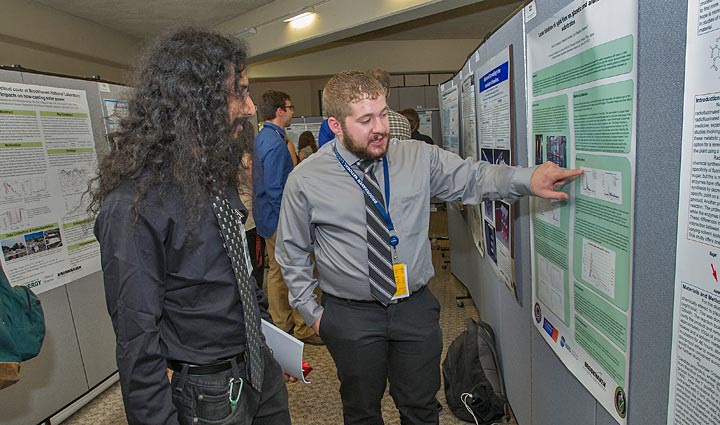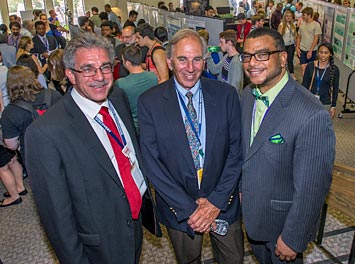Summer Students Invigorate Lab with Energy, Passion for Science
More than 180 interns shared the projects they spent all summer researching at the annual poster session and presentations
August 21, 2014
 enlarge
enlarge
Summer Undergraduate Research Internship (SULI) participant David Cinquegrani shares his research on Brookhaven's Laser Ion Source (LION), which feeds into the Lab's atom smashing Relativistic Heavy Ion Collider (RHIC), with fellow intern Rajeev Seemungal.
This year's crop of Brookhaven National Laboratory summer interns have come and gone, once again invigorating the Lab with their energy and passion for science, technology, engineering, and mathematics (STEM) research.
Coming from universities across the country, more than 180 interns participated in research projects in every corner of the U.S. Department of Energy (DOE) Lab — from nanotechnology to nuclear physics, and renewable energy to nonproliferation. Hand selected by their Brookhaven mentors from a competitive candidacy of thousands of students ranging from high school to the graduate level, the interns got to experience what a career would be like at a national lab. The program — which dates back in some form at Brookhaven to 1952 — supports development of the STEM workforce of the future, whether the interns end up at a university, in industry, or back at a national lab.
“What we want to convey to you is the sense of fun in doing research,” Deputy Lab Director for Science and Technology Robert Tribble said at the closing ceremony. “I hope you’ll take that sense of fun with you back to your universities, think about staying in STEM, and continue on to a research environment in later years. I think you will find that it’s a way that we as scientists can pay back society, and in many cases, help pave the way for advances in society.”
At the culmination of their time here, the summer students presented their research in a poster session aimed at attendees of various scientific backgrounds — encouraging them to communicate their slice of science to those less familiar with it. A number of students were also selected to give full presentations on their research to attentive audiences comprised of their fellow interns, mentors, and colleagues.
Representing the diversity of research at the Lab
At the poster session, Berkner Hall buzzed with excited interns sharing the research that they spent months pouring themselves into, their faces alight with new discoveries. Research that the interns carried out this summer truly reflected the many topics and facets of the Lab, with some projects even focusing on improving Brookhaven’s energy efficiency or day-to-day operations. Some examples:
- Hannah Nelson, a biology senior at Rensselaer Polytechnic Institute, researched the structure and function of a catalyst used to convert toxic chromium-6 — the pollutant made famous by the work of Erin Brockovich — to non-toxic chromium-3. She grew the catalyst, a protein, in the bacteria Escherichia coli, separated out the catalyst using purification techniques, and tried growing it in crystal form. Elucidating the structures of such proteins using powerful tools like the National Synchrotron Light Source (NSLS) at Brookhaven is a way to help learn details about their functions. Nelson said it was an exciting experience to contribute to the ongoing work of her mentor, Subramaniam Eswaramoorthy.
- Physicists at Brookhaven’s Relativistic Heavy Ion Collider (RHIC), a particle accelerator that recreates conditions last seen at the dawn of the universe, are honing designs for a proposed eRHIC upgrade, and hosted summer intern Sarja Lowe. He just graduated with a degree in physics from Bronx Community College, and this summer designed magnets that were cheaper and more efficient than existing models. Lowe said he even got to 3-D print his designs, and that his mentor, Joseph Tuozzolo, is going to incorporate the research into plans for the eRHIC project.
- Since the 32-megawatt Long Island Solar Farm (LISF) began construction in 2010, Brookhaven scientists have been assessing its effects on the surrounding habitat and the creatures that call it home. Erica Bornhoft, who just graduated from the State University of New York-Oneonta, collaborated with her mentor, Tim Green, to survey how the plant and animal life was faring using motion-sensing cameras. Every two weeks, she collected up to 2,000 pictures documenting the movements of LISF wildlife, and found that the solar array was not having negative impacts on plant or animal life. But she didn’t stop there. Bornhoft developed an activity for Brookhaven educators to teach young kids about the effects of human interference with migratory bird patterns.
- Another area of renewable energy research that Brookhaven scientists are working on is hydrogen fuel cell development. Photoelectrochemical (PEC) cells absorb light and split water into oxygen and hydrogen, which can be used as an energy source. Developing catalysts to help this reaction along can improve the efficiency and amount of energy gained from PEC cells. Zoey Warecki, a physics senior at Towson University, worked at the nanoscale to grow zinc oxide wires with varying levels of lithium that can act as a catalyst to speed up the reaction to split water. Under the tutelage of her mentor, Matthew Sfeir, Warecki imaged the tiny nanowires, and suggested the best recipes for optimal use in PEC cells.
Staying in STEM
 enlarge
enlarge
Office of Educational Programs Manager Ken White (left), and educational programs administrators Mel Morris (center) and Noel Blackburn pose for a photo at the poster session.
In their time here, the interns forged valuable relationships with their mentors, colleagues, and fellow students that will help them launch their STEM careers, and benefit them for years to come.
Ken White, manager of the Office of Educational Programs, said at the closing ceremony that Brookhaven scientists work hard to make interns feel like they are part of the research team.
“When you’re here, you’re not a student anymore,” he said. “You’re a researcher, you’re a collaborator, you’re an engineer, you’re part of a team. I hope you leave today feeling like you really are part of a research team and a collaboration that can move forward.”
Tribble ended his remarks with a call to action: “We need you in the long run to help out the country. It’s really important for young students to go into these STEM-related areas and stay in them through their graduate years.”
Undergraduate student internship programs this year were primarily sponsored by the DOE’s Office of Science, Office of Workforce Development for Teachers and Scientists. Additional interns were supported by the National Science Foundation, New York State CSTEP program, and Virginia Pond Scholarship funds.
2014-5075 | INT/EXT | Newsroom









